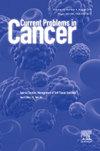A phase 2 prospective trial of re-irradiation of locally recurrent or second primary head and neck tumors using stereotactic body radiation therapy
IF 2.3
4区 医学
Q3 ONCOLOGY
引用次数: 0
Abstract
Objective
To assess SBRT in the reirradiation of head and neck (H&N) cancers.
Patients and Methods
30 patients with 31 sites received SBRT reirradiation to their recurrences, or second primary malignancies (SPM). Doses used were 30-50 Gy in 5 fractions. SBRT reirradiation was used alone for 21 recurrences, while 10 patients received SBRT postoperatively. Assessment of toxicity after reirradiation was done using RTOG scoring criteria.
Results
Median follow up was 18.2 months. In patients treated with RT alone (N = 21), at 3 months post reirradiation, CR (complete response) was achieved in 13 patients (61.9 %). CR rate increased to include 16 patients (76.2 %) at 6 months. In patients treated with adjuvant SBRT (N = 10), at 3 months post reirradiation, no recurrences were observed in 6 patients (60 %).
Median survival was 29.8 months. The 1-year and 2-year OS were 66.2 % and 54.2 % respectively. The 1-year and 2-year PFS were 45.8 % and 32.1 % respectively. The 1-year and 2-year LC were 62.7 % and 54.8 % respectively. The 1-year and 2-year regional control were 79.7 % and 73.6 % respectively. The 1-year and 2-year distant control were 88.4 % and 82.9 % respectively. Acute toxicity of ≥ G3 happened in 5 patients (16.1 %). Late toxicity of ≥ G3 was recorded in 9 patients (29 %).
Conclusion
We reported the 1st prospective phase 2 study in Egypt to use SBRT reirradiation for recurrent H&N cancers. SBRT reirradiation can be a good option for treatment, with good survival and control rates, and acceptable toxicity.
一项使用立体定向全身放射治疗局部复发或第二原发头颈部肿瘤再照射的2期前瞻性试验
目的评价SBRT在头颈部(H&;N)肿瘤再照射中的作用。患者和方法30例31个部位的患者对其复发或第二原发恶性肿瘤(SPM)进行SBRT再照射。剂量为30-50 Gy,分5次使用。21例复发患者单独使用SBRT再放疗,10例术后接受SBRT治疗。再照射后毒性评价采用RTOG评分标准。结果中位随访时间为18.2个月。在单独接受放射治疗的患者中(N = 21),在再照射后3个月,13例患者(61.9%)达到了CR(完全缓解)。6个月时,16例患者(76.2%)的CR率上升。在接受辅助SBRT治疗的患者中(N = 10),在再照射后3个月,6例患者(60%)未观察到复发。中位生存期为29.8个月。1年OS为66.2%,2年OS为54.2%。1年和2年PFS分别为45.8%和32.1%。1年和2年的LC分别为62.7%和54.8%。1年和2年区域控制率分别为79.7%和73.6%。1年和2年远期控制率分别为88.4%和82.9%。急性毒性≥G3者5例(16.1%)。9例(29%)出现≥G3的晚期毒性。结论:我们报道了在埃及进行的第一个前瞻性2期研究,该研究使用SBRT再照射治疗复发性H&;N癌。SBRT再照射是一种良好的治疗选择,具有良好的生存率和控制率,毒性可接受。
本文章由计算机程序翻译,如有差异,请以英文原文为准。
求助全文
约1分钟内获得全文
求助全文
来源期刊

Current Problems in Cancer
医学-肿瘤学
CiteScore
5.10
自引率
0.00%
发文量
71
审稿时长
15 days
期刊介绍:
Current Problems in Cancer seeks to promote and disseminate innovative, transformative, and impactful data on patient-oriented cancer research and clinical care. Specifically, the journal''s scope is focused on reporting the results of well-designed cancer studies that influence/alter practice or identify new directions in clinical cancer research. These studies can include novel therapeutic approaches, new strategies for early diagnosis, cancer clinical trials, and supportive care, among others. Papers that focus solely on laboratory-based or basic science research are discouraged. The journal''s format also allows, on occasion, for a multi-faceted overview of a single topic via a curated selection of review articles, while also offering articles that present dynamic material that influences the oncology field.
 求助内容:
求助内容: 应助结果提醒方式:
应助结果提醒方式:


